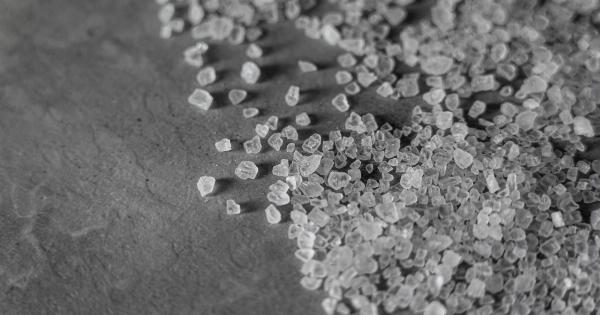When it comes to maintaining a healthy diet, one of the key factors to consider is the amount of sodium, or salt, we consume on a daily basis.
Excessive salt intake has been linked to a range of health issues, including high blood pressure, heart disease, stroke, and kidney problems. While reducing overall salt intake is important, it is particularly crucial to pay attention to the salt content in the first three components of our meals.
These components often form the foundation of our diet and can significantly impact our sodium consumption. In this article, we will explore smart eating strategies to help you steer clear of excessive salt in the first three components of your meals.
1. Protein: Opting for Fresh and Lean Choices
Protein is an essential nutrient that serves as the building block for our muscles, cells, and tissues. However, many protein sources, such as processed meats and canned goods, tend to be laden with salt.
To make smart choices, opt for fresh, unprocessed protein sources such as lean cuts of meat, skinless poultry, fish, tofu, beans, and lentils.
When preparing your protein, season it with herbs, spices, and flavorful marinades instead of reaching for the salt shaker. This way, you can add taste and depth to your meals without overdoing the sodium content.
2. Grains: Going for Whole and Unprocessed Options
Grains are a significant source of carbohydrates, providing energy for our daily activities. Unfortunately, many packaged and processed grain products are often high in sodium.
To steer clear of excessive salt, opt for whole and unprocessed grains such as brown rice, quinoa, whole wheat bread, and oats. These options not only offer more fiber and nutrients but also tend to have lower sodium content.
While cooking grains, avoid adding salt to the water. Instead, enhance the flavor with fresh herbs, spices, or a squeeze of lemon juice. Incorporating these natural flavors can help reduce the need for additional salt in your meals.
3. Vegetables and Fruits: Embracing Nature’s Bounty
Vegetables and fruits are an integral part of a healthy diet, providing essential vitamins, minerals, and fiber. However, even these nutrient powerhouses can become high in sodium if prepared with certain seasonings or sauces.
Opt for fresh or frozen vegetables and fruits instead of canned options, which often contain added sodium.
When cooking vegetables, steaming or roasting them without salt can preserve their natural flavors. Experiment with different herbs and spices to enhance taste instead.
Additionally, eating fresh fruits as a snack or topping for yogurt and cereal is an excellent way to add natural sweetness to your meals without any added sodium.
4. Flavorful Alternatives: Adding Taste without the Salt
If you find yourself missing the familiar salty taste in your meals, there are several alternatives you can turn to that will add flavor without the sodium. Here are a few options:.
Herbs and spices: Experiment with an array of herbs and spices such as basil, rosemary, oregano, cumin, paprika, and turmeric. These can bring a burst of flavor to your dishes without any added salt.
Vinegar and citrus: Adding a splash of vinegar or a squeeze of lemon, lime, or orange can give your meals a tangy kick, enhancing taste without the need for salt.
Sodium-free seasoning blends: Look for sodium-free or low-sodium seasoning blends available in the market. These blends offer a combination of herbs and spices, making them a convenient and tasty option to season your meals.
Homemade sauces and dressings: Prepare your own sauces and dressings using fresh ingredients.
This way, you have control over the sodium content, allowing you to craft delicious and healthy alternatives to store-bought options that are often high in salt.
5. The Role of Reading Labels
When grocery shopping, an important habit to develop is reading food labels. This allows you to make informed choices by identifying products that have excessive sodium content.
Pay attention not only to the sodium levels per serving but also to the serving size itself. Some packages may provide information per portion, while others may display the details for the entire package.
Look for products labeled as “low sodium,” “reduced sodium,” or “no added salt.” However, always verify the nutritional information on the label to ensure these claims are accurate.
Being aware of the sodium content in the products you consume empowers you to make healthier choices and keep your overall salt intake in check.
6. Smart Cooking Tips for Reduced Salt
Aside from selecting low-sodium ingredients, there are several smart cooking techniques that can further reduce the salt content in your meals:.
Rinsing canned goods: If you choose to use canned beans or vegetables, rinse them thoroughly under cold water before cooking. This can help remove excess salt and reduce sodium content.
Boiling and draining: Certain foods, such as cured meats or salted fish, can be soaked, boiled, or blanched to remove some of the salt. Remember to drain and discard the water used for boiling to eliminate the excess sodium.
Portion control: Be mindful of the amount of salt you add to your meals during cooking. Often, a small pinch of salt can go a long way in enhancing flavor.
Gradual reduction: Gradually reduce the amount of salt you use in your recipes over time. This allows your taste buds to adjust to the change, and you will eventually find that you do not need as much salt to enjoy a flavorful meal.
7. Dining Out: Making Healthier Choices
Eating at restaurants or ordering takeout can be a challenge when trying to reduce salt intake. However, there are several strategies you can employ to make healthier choices while dining out or getting food delivered:.
Inquire about preparation methods: Do not hesitate to ask restaurant staff about preparation techniques. Request that your meal be prepared without added salt or seasonings.
Ask for sauce or dressing on the side: Many sauces and dressings contain high amounts of sodium. By asking for them on the side, you can control the amount you use or opt to skip them altogether.
Choose steamed or grilled options: Opt for steamed or grilled dishes instead of anything breaded, fried, or sautéed. These preparation methods tend to add more salt to the dish.
Share your meal or take leftovers: Restaurant portions are typically larger than necessary. Consider sharing a dish with a friend or taking half of it home for another meal. This not only helps control your sodium intake but also saves you money.
8. Building a Balanced Meal Plan
Developing a balanced meal plan plays a crucial role in smart eating and reducing sodium intake. Here’s how you can structure your meals:.
Fill half your plate with vegetables and fruits: Load up on colorful, nutrient-rich vegetables and fruits to ensure you get a wide variety of vitamins, minerals, and fiber.
These components should dominate your plate as they are naturally low in sodium.
Choose lean protein sources: Include lean protein sources such as skinless poultry, fish, tofu, beans, and lentils to provide essential amino acids. These options tend to be lower in sodium compared to processed or canned meats.
Opt for whole grains: Choose whole grains such as brown rice, quinoa, whole wheat bread, and oats to obtain valuable fiber and nutrients. Avoid refined and processed grain products that often contribute to high sodium intake.
Add healthy fats: Incorporate healthy fats in the form of nuts, seeds, avocados, and olive oil to provide additional flavor and nourishment to your meals.
Control portion sizes: Be mindful of your portion sizes to avoid overeating. This not only helps with managing sodium intake but also contributes to maintaining a healthy weight.
9. The Importance of Hydration
Ensuring you stay well-hydrated is essential when striving for a healthy diet low in salt. Water helps your body flush out excess sodium and supports overall well-being.
Aim to consume at least 8 glasses of water per day, and if you engage in physical activities or live in hot climates, increase your intake accordingly.
While hydration is important, be cautious of flavored drinks, sodas, and sports beverages. These can be high in sodium and can contribute to an increased overall salt intake.
10. Seeking Professional Guidance
If you have specific dietary requirements or are unsure how to reduce salt in your meals, it may be beneficial to consult a registered dietitian or nutritionist.
These professionals can provide personalized guidance, meal plans, and recommendations tailored to your needs. They can also help you navigate challenges and provide ongoing support on your journey to smart eating and reduced sodium intake.




























